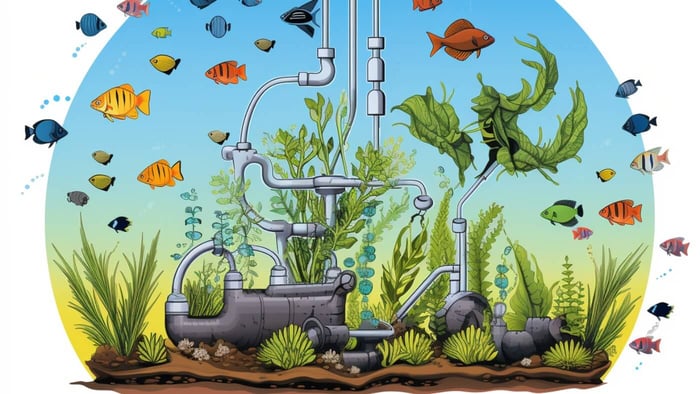Nitrogen Cycle in Reef Aquariums.
Reef aquariums are a captivating world of vibrant corals, colourful fish, and intricate ecosystems. To maintain the health and beauty of a reef tank, it's essential to understand and manage the nitrogen cycle. The nitrogen cycle is a fundamental process that optimises your aquarium's water quality for the inhabitants, ensuring they thrive in their aquatic paradise. This article'll explore the nitrogen cycle, why it's crucial for your reef aquarium, and how you can maintain it effectively.
What is the Nitrogen Cycle?
The nitrogen cycle is a natural biological process that occurs in every fresh and salt aquarium. In the context of reef aquariums, the cycle begins with the introduction of living organisms such as fish, corals, and invertebrates, along with the addition of food and other organic matter. These organisms produce waste in the form of ammonia, which is highly toxic to aquarium inhabitants.
Stages of the Nitrogen Cycle
-
Ammonia: As mentioned earlier, ammonia is the primary waste product in an aquarium. It's produced through the respiration and waste elimination of your reef's inhabitants.
-
Nitrite: Beneficial bacteria called Nitrosomonas begin converting ammonia into nitrite. Nitrite is still toxic to fish and corals, so it's not the final destination.
-
Nitrate: Nitrobacter bacteria then convert nitrite into nitrate, which is less harmful but still detrimental in high concentrations. Nitrate is typically removed through water changes, denitrifying bacteria, and chemical filtration methods.
-
Denitrification: In some reef systems, denitrifying bacteria break down nitrates into nitrogen gas, which harmlessly escapes into the atmosphere, effectively completing the cycle.
Why is the Nitrogen Cycle Crucial in Reef Aquariums?
The nitrogen cycle plays a vital role in maintaining water quality in a reef aquarium for several reasons:
-
Toxicity Reduction: By converting toxic ammonia and nitrite into less harmful nitrate, the nitrogen cycle helps ensure the well-being of your fish, corals, and other reef inhabitants.
-
Stable Water Parameters: Maintaining stable water parameters, such as ammonia, nitrite, and nitrate levels, is essential for the health and longevity of your reef ecosystem.
-
Promoting Coral Health: Corals, in particular, are highly sensitive to water quality. Proper nitrogen cycling is crucial to provide them with the clean water and nutrients they need for growth.
-
Preventing Algae Blooms: Excessive nitrate levels can lead to undesirable algae blooms, which can outcompete corals for light and nutrients. A well-maintained nitrogen cycle helps control these issues.
Maintaining the Nitrogen Cycle
To ensure a thriving reef aquarium, you should consider the following tips for maintaining the nitrogen cycle:
-
Proper Filtration: Use efficient mechanical, biological, and chemical filtration methods to remove solid waste and maintain a healthy population of beneficial bacteria.
-
Regular Water Changes: Regular water changes help dilute nitrate concentrations and replenish essential trace elements.
-
Monitor Water Parameters: Invest in quality water testing kits to monitor ammonia, nitrite, and nitrate levels. Address any irregularities promptly.
-
Avoid Overfeeding: Overfeeding can lead to excess ammonia production. Feed your reef inhabitants in moderation.
-
Establish a Refugium: Adding a refugium to your aquarium setup can provide a habitat for beneficial microorganisms that aid in denitrification.
-
Use Quality Live Foods: When feeding your reef inhabitants, consider using high-quality live foods like phytoplankton, rotifers, and copepods. These foods can contribute to a balanced nutrient cycle in your tank.
Understanding the nitrogen cycle in reef aquariums is crucial to successful reef keeping. Maintaining a healthy nitrogen cycle will ensure your coral and fish thrive in their vibrant underwater world, making your reef tank a true spectacle of nature's beauty.

